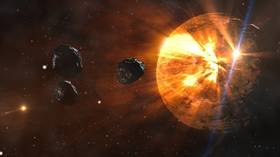Parting gift from 2020? NASA warns FIVE asteroids headed this way

As the widely perceived terrible year of 2020 draws to a close, NASA has shared an alert about five asteroids due to shoot past the Earth on Wednesday and later this week, two of which will come closer to our planet than the Moon.
Some three space rocks, ranging in diameter from roughly a telephone pole size all the way up to two London buses end-to-end, will shoot past the Earth on Wednesday.
The 11-meter asteroid named 2020 XF4 will flyby at 343,000km (213,130 miles) followed by the 24-meter 2020 VY1 at five million kilometers, with 2020 XS5 bringing up the rear at an equally safe distance of three million km. For reference, the average distance between Earth and the Moon is roughly 385,000 kilometers (239,000 miles).
Also on rt.com Global mass extinctions follow regular 27-million-year cycle, may be linked to Earth’s journey through Milky WayAnd right as the weekend is beginning for many, on Friday, the comparatively tiny 6.6-meter 2020 XX3 will scream past the Earth at a distance of 57,100km, followed shortly afterwards by the 30-meter space rock 2020 XF3 which will give the planet a much wider berth, passing at 6.9 million km.
Meanwhile, in more positive news, Japanese scientists are ecstatic after seeing the unexpectedly large quantities of dust and gas taken from the Ryugu asteroid, after opening the sealed capsule dropped off to Earth by the Hayabusa2 probe.
The Hayabusa craft made the roughly 400 million km round trip to collect and return subsurface samples from the distant asteroid, to potentially unlock some of the mysteries of the universe, including the origins of life on Earth.
The mission may also yield insights into how best to prepare our planetary defenses in the event that an inbound asteroid strays any closer than this week’s collection of cosmic artillery.
“When we actually opened it, I was speechless. It was more than we expected and there was so much that I was truly impressed,” said Japan Aerospace Exploration Agency (JAXA) scientist Hirotaka Sawada.
“It wasn’t fine particles like powder, but there were plenty of samples that measured several millimeters across.”
Also on rt.com ‘I probably screamed’: Japanese researchers thrilled after securing Ryugu asteroid samples beyond their expectationsInitial examinations indicate the samples contain “plenty of organic matter” according to Hayabusa project scientist and professor at Nagoya University Seiichiro Watanabe.
As further examinations and studies are conducted here on Earth, the Hayabusa2 probe is heading back out to continue its mission and visit two other asteroids in the hunt for more answers about life and the universe.
Think your friends would be interested? Share this story!














